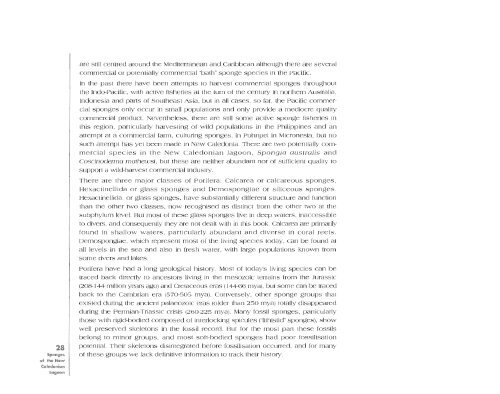Sponges of the New Caledonian lagoon - IRD
Sponges of the New Caledonian lagoon - IRD
Sponges of the New Caledonian lagoon - IRD
Create successful ePaper yourself
Turn your PDF publications into a flip-book with our unique Google optimized e-Paper software.
28<br />
Sponge.<br />
<strong>of</strong> <strong>the</strong> <strong>New</strong><br />
<strong>Caledonian</strong><br />
Lagoon<br />
are still centred around <strong>the</strong> Mediterranean and Caribbean although <strong>the</strong>re are several<br />
commercial or potentially commercial "bath" sponge species in <strong>the</strong> Pacific.<br />
In <strong>the</strong> past <strong>the</strong>re have been attempts to harvest commercial sponges throughout<br />
<strong>the</strong> Indo-Pacific. with active fisheries at <strong>the</strong> turn <strong>of</strong> <strong>the</strong> century in nor<strong>the</strong>rn Australia.<br />
Indonesia and parts <strong>of</strong> Sou<strong>the</strong>ast Asia. but in all cases. so far. <strong>the</strong> Pacific commercial<br />
sponges only occur in small populations and only provide a mediocre quality<br />
commercial producT. Never<strong>the</strong>less. <strong>the</strong>re are still some active sponge fisheries in<br />
this region. particularly harvesting <strong>of</strong> wild popuJations in <strong>the</strong> Philippines and an<br />
attempt at a commercial farm. culturing sponges. in Pohnpei in Micronesia. but no<br />
such attempt has yet been made in <strong>New</strong> Caledonia. There are two potentially com<br />
mercial species in <strong>the</strong> <strong>New</strong> <strong>Caledonian</strong> <strong>lagoon</strong>. Spongio oustro}is and<br />
Coscinodermo mo<strong>the</strong>wsi. but <strong>the</strong>se are nei<strong>the</strong>r abundant nor <strong>of</strong> sufficient quality to<br />
support a wild-harvest commercial industry.<br />
There are three major classes <strong>of</strong> Porifera: Calcarea or calcareous sponges.<br />
Hexactinellida or glass sponges and Demospongiae or siliceous sponges.<br />
Hexactinellida. or glass sponges. have substantially different structure and function<br />
than <strong>the</strong> o<strong>the</strong>r two classes. now recognised as distinct from <strong>the</strong> o<strong>the</strong>r two at <strong>the</strong><br />
subphylum level. But most <strong>of</strong> <strong>the</strong>se glass sponges live in deep waters, inaccessible<br />
to divers. and consequently <strong>the</strong>y are not dealt with in this book. Calcarea are primarily<br />
found in shallow waters, particularly abundant and diverse in coral reefs.<br />
Demospongiae, which represent most <strong>of</strong> <strong>the</strong> liVing species today, can be found at<br />
all levels in <strong>the</strong> sea and also in fresh water, with large populations known from<br />
some rivers and lakes.<br />
Porifera have had a long geological history. Most <strong>of</strong> today'S liVing species can be<br />
traced back directly to ancestors living in <strong>the</strong> mesozoic terrains from <strong>the</strong> Jurassic<br />
(208- 144 million years ago) and Cretaceous eras (144-66 mya), but some can be traced<br />
back to <strong>the</strong> Cambrian era (570-505 mya). conversely. o<strong>the</strong>r sponge groups that<br />
existed during <strong>the</strong> ancient palaeozoic eras (older than 250 mya) totally disappeared<br />
during <strong>the</strong> Permian-Triassic crisis (260-225 mya). Many fossil sponges, particularly<br />
those with rigid-bodied composed <strong>of</strong> interlocking spicules Clithistid" sponges). show<br />
well preserved skeletons in <strong>the</strong> fossil record. But for <strong>the</strong> most part <strong>the</strong>se fossils<br />
belong to minor groups. and most s<strong>of</strong>t-bodied sponges had poor fossilisation<br />
potential. Their Skeletons disintegrated before fossilisation occurred, and for many<br />
<strong>of</strong> <strong>the</strong>se groups we lack definitive information to track <strong>the</strong>ir history.

















